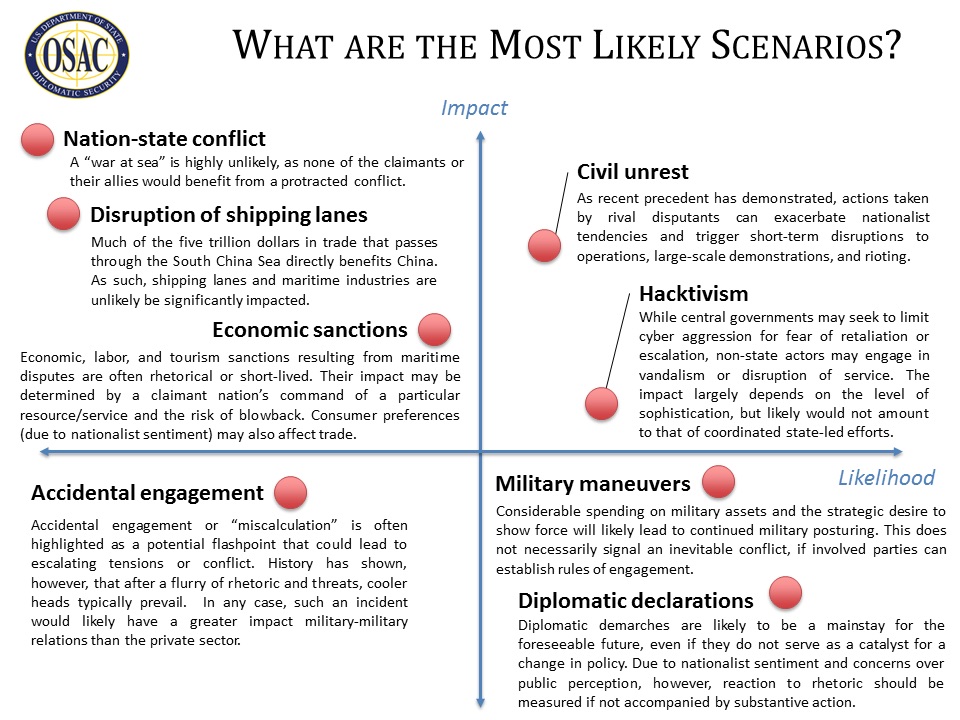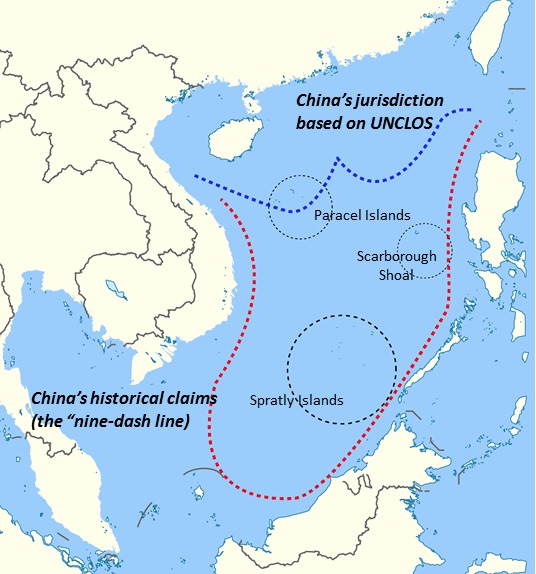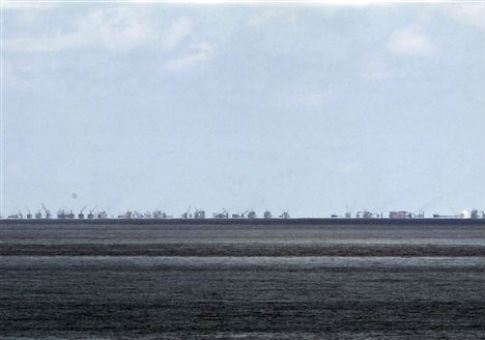China will continue building islands in the disputed waters of the South China Sea but a major conflict in the region over the dispute is unlikely, according to a State Department security report.
"Beijing will continue to develop contested territories in the South China Sea," says the internal report by the Overseas Security Advisory Council (OSAC). "Unlike fishing boats or patrol vessels, infrastructure investments, such as land reclamation and the construction of runways and lighthouses, signal a more permanent presence."
The report’s conclusion that China will continue island-building and militarization in the sea contrasts with the message sent last week by Defense Secretary Ash Carter.
In several speeches and comments during a visit to Asia, Carter called on China to halt the building, which to date has produced some 2,000 acres of new islands, and the construction of military facilities and deployment of weapons systems on the islands.
Carter told reporters in Vietnam June 1 that the United States wants a "permanent halt to reclamation and militarization" in the South China Sea.
"The United States opposes militarization and the creation of tensions in the South China Sea," Carter said during a visit to Hanoi, which in response to China’s island-building also has been constructing some new sea islands.
Carter also said U.S. military ships and aircraft would not be forced by China to stop conducting surveillance flights or ship transits in the sea.
"No actions by any party will change the United States’ behavior," he said. "We will fly and sail and operate wherever international law permits and that will remain unchanged."
A Navy P-8 aircraft conducted a surveillance flight over the sea May 20. During the flight, a Chinese air controller repeatedly ordered the aircraft to leave the region.
In December, a Chinese warship in December nearly collided with the USS Cowpens, a guided-missile frigate, by sailing in front of the U.S. warship and stopping suddenly. The Pentagon called the South China Sea encounter dangerous.
The OSAC report states that war between China and claimants to areas of the sea is highly unlikely but warned of other lower-level dangers that could lead to conflicts or military incidents.
The assessment of South China Sea tensions is contained in the internal report prepared by State’s Office of Diplomatic Security to assist U.S. companies operating in the region.
The report seeks to assist U.S. businesses in the region in dealing with the impact of South China Sea disputes that may escalate. The dispute was triggered by China’s claims to sovereignty over 90 percent of the sea, and disputes with regional states, mainly Vietnam, Philippines, and Malaysia.
The main danger outlined in the report is what is described as an "accidental engagement" or military miscalculation that could become a "potential flashpoint that could lead to escalating tensions or conflict."
"History has shown, however, that after a flurry of rhetoric and threats, cooler heads typically prevail," the report said. "In any case, such an incident would likely have a greater impact [on] military-military relations than the private sector."
"A ‘war at sea’ is highly unlikely, as none of the claimants or their allies would benefit from a protracted conflict," the report said.
The war at sea option is one of several scenarios listed on a graphic produced in the nine-page report on the possible outcomes.

Civil unrest is also a concern from the South China Sea disputes. "As recent precedent has demonstrated, actions taken by rival disputants can exacerbate nationalist tendencies and trigger short-term disruptions to [business] operations, large-scale demonstrations, and rioting," the report said.
After China deployed a floating oil platform rig to the Paracel Islands, in the northern part of the sea near Vietnam, thousands of Vietnamese workers went on a rampage, setting fire to factories and damaging foreign assets to protest the Chinese actions.
Hacker attacks also could grow out of the maritime dispute. "While central governments may seek to limit cyber aggression for fear of retaliation or escalation, non-state actors may engage in vandalism or disruption of service," the report said. "The impact largely depends on the level of sophistication, but likely would not amount to that of coordinated state-led efforts."
The most likely scenarios in the sea dispute are increased military posturing and diplomatic protests.
"Considerable spending on military assets and the strategic desire to show force will likely lead to continued military posturing," the report said, adding that posturing would "not necessarily signal an inevitable conflict, if the involved parties can establish rules of engagement."
As for diplomacy, "diplomatic demarches are likely to be a mainstay for the foreseeable future, even if they do not serve as a catalyst for a change in policy," the report said.
"Due to nationalist sentiment and concerns over public perception, however, reaction to rhetoric should be measured if not accompanied by substantive action."
The dispute over the mostly uninhabitable islands stems from China’s goal in seeking legal jurisdiction over what are strategic international waters that the report says handle $5 trillion in trade through sea lanes. The waters also have large undersea energy resources coveted by China.
"Not only are the disputed territories located along some of the world’s busiest sea lands, many are believed to contain significant energy deposits and fish stocks," the report said.
China also has made a vague, legally questionable claim to own some 90 percent of the South China Sea covered by what Beijing says is a historically "nine-dash line" throughout the waters.

The report noted Chinese military demands from a ground controller on one of the new islands who warned a Navy surveillance plane to leave the area of Fiery Cross Reef, in the Spratlys near the Philippines where a military runway is under construction.
The South China Sea dispute has been underway for at least six yeas, but only recently garnered high-level attention from the Obama administration.
David Shear, assistant defense secretary for Asia and Pacific affairs, told a Senate hearing May 13 that U.S. forces will defend American national security interests in the South China Sea in the face of growing Chinese territorial encroachment.
Shear said China has been building up military facilities on the islands, including a runway on one. Recent reports indicated China has deployed artillery on some of the newly created islands.
To counter the Chinese, Shear told a Senate hearing the Pentagon is upgrading alliances with states in the region. Pentagon officials also said U.S. forces planned to conduct ship transits and aerial reconnaissance flights within 12 miles of the new islands, activities that likely will trigger Chinese aerial intercepts or warship incidents of U.S. forces.
John Tkacik, a former State Department specialist on China, said he regards the possibility of China using its coast guard and naval forces to prevent other countries in the region from construction or oil exploration in the South China Sea.
"I am not confident that the State Department is sufficiently engaged with the Vietnamese on their strategy to forestall China’s inexorable expansion and the consolidation of its maritime control of the Sea," Tkacik said.
"We have seen from the warnings transmitted to U.S. reconnaissance aircraft by Chinese ground stations on some of the reclaimed reefs that the People’s Liberation Army certainly considers the Sea to be China’s, the sea beds to be Chinese territory, the sea lanes to be Chinese waters, and the airspace above the entire South China Sea to be Chinese airspace."
Tkacik says it is highly likely People’s Liberation Army forces will continue to harass both air and naval transits to test where U.S. forces will relent or withdraw, or observe where there will be a U.S. push back.
Chinese military and naval maneuvers will be conducted to harass and threaten U.S. aircraft and ships, and China’s foreign ministry also will be issuing diplomatic protests.
"The PLA’s strategy is to push the U.S. right up to the breaking point, then to relent for a period so the U.S. can get used to it," Tkacik said.
"The Chinese military will use its electronic intelligence-gathering to assess U.S. military "breaking points," he said.
"And once the PLA feels the U.S. has gotten used to China’s belligerence, the PLA then will push past the old ‘breaking point’ and establish a new breaking point," he said.
Thus an accidental engagement is not likely, since all engagements by the Chinese will be calculated and intentional.
"The Chinese may ‘miscalculate’ by pushing the U.S. so far that the U.S. position in Southeast Asia becomes non-credible unless there is a forceful response, but that will come after the U.S. pushes well past the breaking point. In that case, the U.S. may engage in a violent lash back out of desperation."
